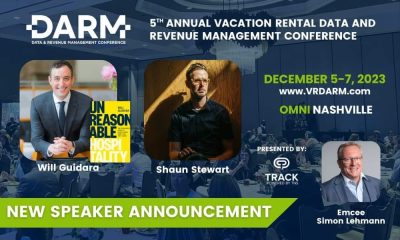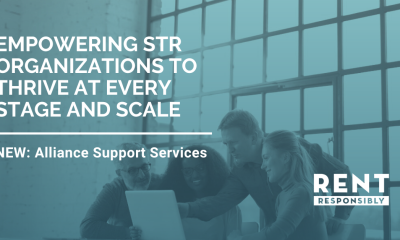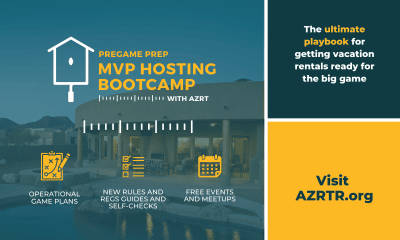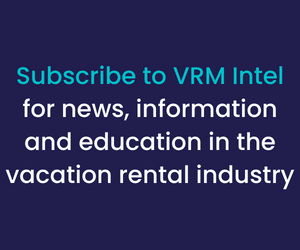
Providing great experiences for your guests and homeowners is key to the success of your property management business. But what about your employees? How would you rate their experience? Just as marketing has moved beyond looking at guest satisfaction to looking at the total guest experience, it is now time for businesses to refocus their efforts on strategies that build on and continuously improve their employees’ experiences.
Understanding your employees’ experiences, what they encounter, what they observe, and how they feel on their path in your business is a vital trend for 2018. Employees’ experiences begin with their first touch point and carry through to their last—recruitment, onboarding, daily activities, ongoing education and training, career opportunities, succession planning, and termination. The experience is more than what annual employee surveys or performance evaluations reveal. It is the employees’ daily journey and whether they like it or not.
Providing an engaging employee experience is a differentiator for you and your business. Strong employee experiences drive employee engagement, which in turn helps you attract and retain a skilled workforce.
Culture
Culture is what we call the office vibe. Once thought to be a fluffy idea, creating the culture you want has become a business priority. It plays a significant role in how your employees feel and whether they enjoy or hate coming to work each day. Culture includes organizational structure, leadership style, compensation and benefits, conflict and resolution management—anything that impacts your employees and their interactions in the workplace.
Your objective is to create a road map that people can follow. Organizational culture plays a key role in your success. What do you value in a leader? What do you value in the people who work for you? What are the most important characteristics you want to embed in your business to create a culture for success?
A great culture is aligned with your company’s business goals and is well communicated. A few warning signs that might indicate of lack of alignment include the following:
- People make excuses and blame others for lack of progress.
- If you ask for opinions on a business decision, people don’t speak up.
- In meetings, people bring up issues that you thought were resolved.
From a cultural viewpoint, one of the greatest challenges is to unite employees from diverse backgrounds and experiences to work together to achieve the desired results. Creating a positive and productive culture gives you a competitive advantage.
Step 1: Define Core Competencies
Do you know which key competencies are required for success in your business? For example, success might look like an employee who delivers on commitments to goals and results consistently. These employees take risks when appropriate and persevere through daunting obstacles. Ultimately, these employees are intrinsically motivated to work long and hard to achieve the needed results.
What other competencies are required to create a positive and productive culture in your business? Take time to identify what is most important to you, your business, and the culture you want to create to determine which competencies are core to your business. Core competencies such as business ethics, integrity, innovation, problem-solving, and customer service typically rise to the top of the list. What’s at the top of your list?
Step 2: Assess Your Current Employees
Do they have what it takes? What are your nonnegotiables? Remember, you are seeking the right people with the right competencies in the right place at the right time. There are many personas in the workplace—underachievers, good performers, strong managers, and high-potential leaders, to name a few. Developing an evaluation form to assist you with assessing your talent is a great place to start. The objective is to measure their success based on core competencies: how they perform, their areas to strengthen, and their potential for future growth.
Another approach to consider when assessing your employees’ performance is to think about it from a succession planning perspective. Do you have the people you need to move into other positions, or do you need to look externally? You can assess your employees’ potential for future growth in the company by identifying their performance as one of the following: too new to assess, fits best in position, promotable to a new position, or replaceable. This information will provide you with a road map for succession, identifying if you have the skill sets and talent in house to develop or if you need to look externally for certain positions.
Step 3: Find the Right Fit
Good training will not make up for bad selection. A key motto in the small business world is to hire like your life depends on it—because it does. Tim Ferriss, author of The 4-Hour Workweek, says that hiring the right people can make or break a company. Hiring is a time-consuming process, one that pays dividends when done right. Be patient. Even though you need to hire quickly, don’t be hasty.
One of the most important decisions you make is who to hire. Your new hire represents you and your company. Defining company core values in advance of designing your hiring plan is a critical component for success. Start interviewing for core values and not just the essential functions of the position and the experience of the candidate. Create a realistic hiring timeline that plans for being patient; it takes time to find the right person.
Don’t be afraid to hire someone who knows more and has more experience than you. Often, we think of employment diversity as those employees who are of a different race, sex, or age. Diversity can also mean differences in thinking, ideas, perspectives, and personalities.
Having diversity in the workplace has benefits. Incorporating diversity into your daily operations broadens your thinking, generating different ideas and perspectives. Each employee’s perception, approach, ideas, capabilities, and resolutions will be varied. These differences will produce an outcome that is more likely to reach a broader audience and capture new customers than one or two employees who think similarly.
Step 4: Manage Performance
Hold employees accountable. Identify expected performance levels, and encourage high levels of performance. Measure individual performance, evaluate, and provide meaningful and timely feedback. Provide employees with assistance, and reward or discipline when necessary. Holding employees accountable is essential to managing performance.
What is accountability? Accountability is delivering on commitment. It is the result of responsibility for an outcome beyond tasks. And it is necessary in all roles within the organizational structure. How do you create a culture of accountability? Harvard Business Review published “The Right Way to Hold People Accountable” by Peter Bregman, who states that there are five “clear areas” to hold people accountable the right way—expectations, capability, measurement, feedback, and consequences—and often these areas lack clarity in the workplace.
Begin with clear expectations. Be clear about the outcome you want, how you’ll measure success, and how people will achieve the outcome. Have a conversation, and plan for your people to be a part of it. Great employees will offer ideas and strategies to achieve. After talking about it, write it down and share it.
Have a clear set of capabilities. What skills do people need to meet expectations? Do they need resources? Do they have the skills? If not, can you provide or teach them? If they don’t have the capacity, find someone else. Set your people up to succeed, not fail.
Create clear measurements. Failure is preventable. During the clear expectations part of this process, agree on weekly milestones meetings to monitor progress. If they are not meeting their targets, then act immediately. Brainstorm a solution, then respond to get each employee back on track.
Give clear feedback. Provide timely and honest feedback. With clearly defined expectations, capabilities, and measurements, feedback is factual and easy to deliver. Are employees delivering on their commitments? Are they working effectively with other people? Do they need to increase their capabilities? Provide feedback weekly. Helpful feedback is more useful than being nice.
Share clear consequences. If you have been clear in these areas, then you have reasonable cause to act. You have three actions: repeat, reward, or release. If you do not feel confident in your leadership, repeat the five clear areas to clarify. Reward people if they succeed. If you are certain you have followed the five clear areas, and the person has not been accountable, then he or she is not fit for the role, and it’s time to release (change roles, termination, etc.).
Focusing on improving accountability will increase your employees’ performance and productivity.
Step 5: Train and Retrain the Right People
Foster a culture of training and development. Create and maintain a culture that values and respects individuals. Identify future needs and how to develop individuals to fill these needs. (This is succession planning at its finest.) Providing ongoing training and development opportunities is a key strategy to grow and retain your talent.
Key Takeaways
The power of employee experience shows that its return on investment may be more than you think. Employee experience programs must directly link to your business’s mission, core values, and goals and objectives. Finding ways to continually engage employees in your business has a direct return on investment on the loyalty, productivity, profitability, and retention of your guests, homeowners, and employees.
Make your employees’ experiences a priority, and watch magic happen.












Thanks for the informative article, Sue! I definitely agree, when you are working with people and building relationships with them, it helps to have some perspective and understanding of their cultures.